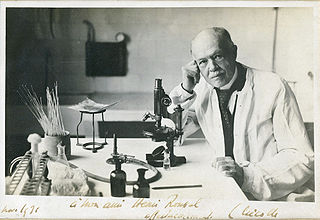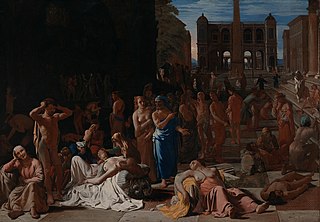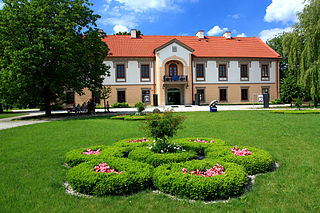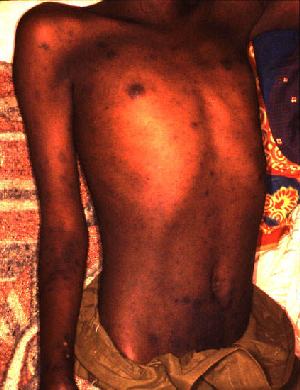Related Research Articles

Epidemic typhus, also known as louse-borne typhus, is a form of typhus so named because the disease often causes epidemics following wars and natural disasters where civil life is disrupted. Epidemic typhus is spread to people through contact with infected body lice, in contrast to endemic typhus which is usually transmitted by fleas.
Brill–Zinsser disease is a delayed relapse of epidemic typhus, caused by Rickettsia prowazekii. After a patient contracts epidemic typhus from the fecal matter of an infected louse, the rickettsia can remain latent and reactivate months or years later, with symptoms similar to or even identical to the original attack of typhus, including a maculopapular rash. At such times, typhus can be transmitted to other individuals through fecal matter of the louse vector, and generate a new epidemic of the disease.

Scrub typhus or bush typhus is a form of typhus caused by the intracellular parasite Orientia tsutsugamushi, a Gram-negative α-proteobacterium of family Rickettsiaceae first isolated and identified in 1930 in Japan.
Rickettsia prowazekii is a species of gram-negative, alphaproteobacteria, obligate intracellular parasitic, aerobic bacillus bacteria that is the etiologic agent of epidemic typhus, transmitted in the feces of lice. In North America, the main reservoir for R. prowazekii is the flying squirrel. R. prowazekii is often surrounded by a protein microcapsular layer and slime layer; the natural life cycle of the bacterium generally involves a vertebrate and an invertebrate host, usually an arthropod, typically the human body louse. A form of R. prowazekii that exists in the feces of arthropods remains stably infective for months. R. prowazekii also appears to be the closest free-living relative of mitochondria, based on genome sequencing.

Charles Jules Henri Nicolle was a French bacteriologist who received the Nobel Prize in Medicine for his identification of lice as the transmitter of epidemic typhus.

The Plague of Athens was an epidemic that devastated the city-state of Athens in ancient Greece during the second year of the Peloponnesian War when an Athenian victory still seemed within reach. The plague killed an estimated 75,000 to 100,000 people, around one quarter of the population, and is believed to have entered Athens through Piraeus, the city's port and sole source of food and supplies. Much of the eastern Mediterranean also saw an outbreak of the disease, albeit with less impact.

Murine typhus, also known as endemic typhus or flea-borne typhus, is a form of typhus transmitted by fleas, usually on rats, in contrast to epidemic typhus which is usually transmitted by lice. Murine typhus is an under-recognized entity, as it is often confused with viral illnesses. Most people who are infected do not realize that they have been bitten by fleas. Historically the term "hunger-typhus" was used in accounts by British POWs in Germany at the end of World War I when they described conditions in Germany.

Rozwadów is a suburb of Stalowa Wola, Poland. Founded as a town in 1690, it was incorporated into Stalowa Wola in 1973. The Rozwadów suburb of Stalowa Wola included a thriving Jewish shtetl prior to World War II, closely associated with the Jewish communities of Tarnobrzeg and other nearby shtetls including Ulanów, Mielec, and Dzików. These communities, infused with vitality before 1939, were utterly destroyed by the Germans during the Holocaust.
A rickettsiosis is a disease caused by intracellular bacteria.

Typhus, also known as typhus fever, is a group of infectious diseases that include epidemic typhus, scrub typhus, and murine typhus. Common symptoms include fever, headache, and a rash. Typically these begin one to two weeks after exposure.

Typhus vaccines are vaccines developed to protect against typhus. As of 2020 they are not commercially available.
Tick-borne lymphadenopathy is a condition characterized by lymphadenopathy and a rash.
Flying squirrel typhus is a condition characterized by a rash of early macules, and, later, maculopapules.

The Cork Street Fever Hospital, also known as the House of Recovery, was a hospital located in Cork Street in Dublin, Ireland.
The typhus epidemic of 1847 was an outbreak of epidemic typhus caused by a massive Irish emigration in 1847, during the Great Famine, aboard crowded and disease-ridden "coffin ships".

Diseases and epidemics of the 19th century included long-standing epidemic threats such as smallpox, typhus, yellow fever, and scarlet fever. In addition, cholera emerged as an epidemic threat and spread worldwide in six pandemics in the nineteenth century.

The Cocoliztli Epidemic or the Great Pestilence was an outbreak of a mysterious illness characterized by high fevers and bleeding which caused 5–15 million deaths in New Spain during the 16th century. The Aztec people called it cocoliztli, Nahuatl for pestilence. It ravaged the Mexican highlands in epidemic proportions, resulting in the demographic collapse of some Indigenous populations.

The NHS Louisa Jordan was a temporary emergency critical care hospital created to deal with the COVID-19 pandemic in Scotland. It was located within the SEC Centre in Glasgow.
In the early stages of the First World War, Serbia suffered an epidemic of typhus and relapsing fever. The epidemic first appeared in the late autumn of 1914, after the second Austrian offensive. By December the Austro-Hungarian troops were pushed out of Serbia for the second time in ten days. Around 50,000 wounded and sick remained in hospitals. Great problems with the lack of accommodation and food were affecting not only hospitals but the civilian population as well, besides that, there were around 50,000 Austro-Hungarian prisoners that had to be accommodated and fed too. Dr. Roman Sondermajer established a large field hospital near Kragujevac, using army barracks to care for the sick and wounded.

Finnic incantations or charms are a body of traditional literature in the Finnic languages whose purpose was to effect magical change on the world. They were most often used to ward off diseases and injuries and to ensure economic prosperity in farming, hunting, fishing and cattle-raising, though spells were used in various social situations and everyday tasks. Such incantations were in widespread use from the first extensive documentation of Finnic-language cultures around the late eighteenth century through to the advance of modernisation in the early twentieth; one marker of this popularity is that more than 30,000 verse spells were collected from Finland and Karelia and published in the series Suomen Kansan Vanhat Runot.
References
- ↑ Ulla Piela, 'Loitsut 1800-luvun Pohjois-Karjalassa', Kalevalaseuran vuosikirja, 68 (1989), 82–107 (pp. 83–84).